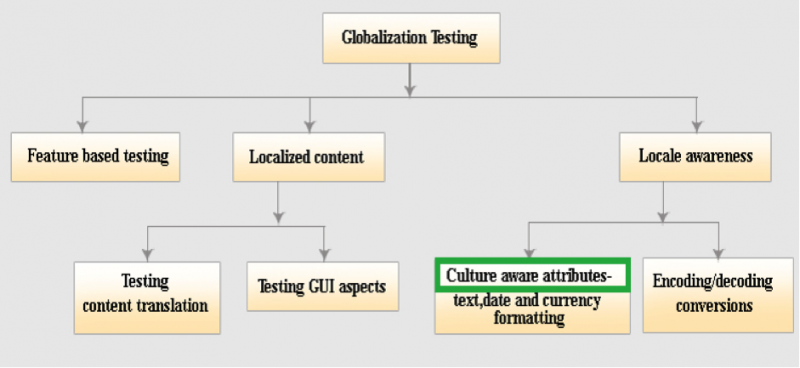Software products today are made for global consumption, so globalization is an important step in ensuring engineering efforts are sufficient for worldwide markets. As part of globalization, internationalization and localization are attributes that organizations have long taken care of. However, there is another important piece that is becoming recognized: the linguistic part of the engineering.
While linguistic nuances need to be largely taken care of during the requirements and design phases, there is a critical role to play in the testing phase, too. Let’s look at what linguistic testing is, product examples that necessitate this work, what to bring in scope for linguistic testing, and how locale-specific cultures play an important part in enabling linguistic support. Here’s how to design the best strategy for implementing a linguistic test effort.
What Is Linguistic Testing?
So, what is linguistic testing? A globalization effort encompassing internationalization (covering areas such as pseudolocalization) and localization (covering localization UI, functionalism, and translation) testing is what we’ve traditionally known. Linguisting testing fits under the localization umbrella—the localized content, screens, functionality, and UI are tested not just for overall accuracy, but also for the cultural context of the market the product is intended for.
For example, the piece of content in French meant for the France market may not fully work as is for the Canada market, from a cultural context standpoint. The engineering team, including the stakeholders, needs to understand that there are cultural attributes that need to be engineered in and tested for as part of the localization process.
To that extent, linguistic engineering that brings in market nuances is not different from localization. The difference is that localization testing (which is a superset) focuses on functional, UI, and core translation elements, while linguistic testing (which is a subset) focuses on context in linguistic usage.

Let’s look at this with a simple example. Culture is a set of practices that build and complete an experience associated with a certain region and group of people. For example, a westerner traveling to Asia who is offered food with chopsticks or is asked to eat with their hands may have a huge culture shock if not aware of these practices. Considering this small experience that may last just a few days, you can imagine what it would be like to deal with a culture shock quotient in applications to be used for a long period of time by millions of users.
Linguistic testing therefore becomes very important, as mere localization testing cannot gauge market readiness. Language errors that may seem trivial can have a hugely adverse impact, and certain nuances may not be fully verified by localization testers alone.
To give another example, Heineken was doing a marketing campaign for the 1994 World Cup and printed the flags of all the finalists on its beer bottles. Saudi Arabia was one of the finalists, but its flag has an inscription from the Quran, and printing it on the beer bottle created a lot of adverse reactions from people in that country. Similarly, Pepsi recently had a campaign that said “Come alive with the Pepsi generation.” This slogan fell apart in the Taiwan market, where “come alive” has the connation of reanimating deceased ancestors!
These examples highlight the need for sensitized attention to use of content, colors, and images in global products.
What Linguisting Testing Entails
With this context, let’s look at what to include in the scope of linguistic test coverage. My company likes to look at this coverage from an iceberg model to include both what is obviously visible and what may not be fully visible sometimes, even to the trained eye. These are the overt and covert issues in linguistic testing.
Obviously visible issues include truncations, text overlap, mistranslation, inconsistency in terminology, ambiguous instructions to end-users, missing voices, and issues with animation, to name a few. Some of these issues, such as mistranslation, border with localization’s functional and UI testing and can be found by the localization testers. But for the other attributes—especially for certain complex languages, including “right to left” languages such as Arabic and Hebrew—specialized linguistic testers become necessary.
For example, in a table with numbers, in English the numbers after one are plural. But in Arabic and Sanskrit, for instance, numbers after one are not plural and are mostly written in words instead of numerals. They have three cases to be applied on objects followed by numbers: singular case, dual case, and plural case. If you don’t engage a linguistic tester in the early phases of your product, chances are higher that you will have to subsequently make changes at a design level.
And despite the name, linguistic testing doesn’t only pertain to wording. Other test attributes that are important from a cultural angle include high and low power distances, color profiles, symbols and icons, font sizes, graphics and icons (especially for the low-literacy markets), regional names, and border disputes. While some of these considerations may appear straightforward, they have a lot of cultural interpretation that a native would know better than someone who only knows the language.
For example, one of my company’s clients was entering the Middle East and North Africa market. Product design, development, and testing was completed and handed off to the marketing team, which was going to ship the products with the same boxes they used in western markets. These boxes had a lot of pictures of women that would be fine in Europe and North America, but in the Middle East and North Africa, it is not acceptable to picture women without hijab. We informed the marketing team about the cultural dynamics, and the shipping date was put on hold until new boxes were designed. We were able to avoid a major cultural faux pas with timely intervention.
It’s important to consider language, dialect, religion, cuisine, social habits, music, art, festivals, and holidays in your linguistic testing to ensure the entire cultural angle is taken care of, rather than just the language translation. This is why it is increasingly important to have not just localization testers, but linguistic testers (including native users) who evaluate the application before it goes live.
Culture has its own dimensions around whether it is pragmatic or normative, individualistic or collective, masculine or feminine, etc. These are deep-rooted nuances in defining a region, and it is often not possible for someone who just knows the language to test an app or product from these different dimensions. These need to be kept in mind from the design stage, which necessitates linguistic validation from the beginning.
Building Your Linguistic Testing Team
Given these challenging requirements, who should be on the linguistic testing team? These testers should be resident subject matter experts who understand local experiences through research or having lived in the region, besides just knowledge of the language.
At my organization, for example, given the scope of linguistic testing projects we undertake, we have linguistic subject matter experts and partners in a range of languages whom we employ on a freelance basis in a crowdsourced testing model. A good model for linguistic testing incorporates a mix of testers and native end-users. While you may not be able to leverage your localization testers for linguistic testing, the other way around is possible with a little bit training to enable them to take on a larger testing effort.
Here are some of the core linguistic testing best practices:
- Identify coverage and the team early on
- Decide when to onboard the testing team
- Simplify the test process—not all linguistic testers are test-savvy
- Be open to localization defects from linguistic testers, and vice versa
- Incorporate a linguistic review at the design stage
- Review linguistic defects reported from field
In today’s global markets, it’s cruicial not to underestimate the need for linguistic testing. Testers should understand the difference between localization and linguistic testing. Choose your linguistic team carefully, as they can make all the difference in ensuring quality for your application. And as a starting step, create linguistic awareness in the team about what is required to embrace linguistic testing, and accommodate time and resources for them to do their job.


User Comments
I have never worked on liguistic testing. Thank you for sharing this information with us. And I also thinks building a linguistic team is also a tough task.
I work in an agile testing environment and I knows the challenges that I face on daily basis in handling the team.